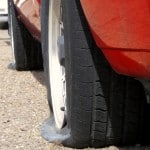South Carolina Defective Tire Lawsuits
 When a tire is defectively manufactured or designed, it can have severe consequences. More than 8,000 motor vehicle accidents per year are caused by tire failure. Many of these failures are the direct result of a manufacturing or design defect, including poor design, faulty or incompatible materials, improper tire storage or flawed production and manufacturing.
When a tire is defectively manufactured or designed, it can have severe consequences. More than 8,000 motor vehicle accidents per year are caused by tire failure. Many of these failures are the direct result of a manufacturing or design defect, including poor design, faulty or incompatible materials, improper tire storage or flawed production and manufacturing.
While most drivers will log many hundreds and probably thousands of miles without so much as an air leak, tire failures occur regularly. While every tire failure does not result in a serious accident, the sudden failure of a tire can cause a vehicle to lose control and either roll over or collide with another vehicle. Tire failures are especially dangerous when the vehicle is traveling at a high speeds on the interstate. Tire failures are also more likely to lead to rollovers when they occur on a vehicle with a high center of gravity, such as many popular sport utility vehicles.
A tire can be defective and dangerous in several ways:
Aged tires — Every new tire has a limited useful life. Tires are made of rubber, which changes chemically over the years. Even if a tire has never been used, it can be defective merely because it has spent too much time in a warehouse or on the retailer’s shelf. If you were sold a six-year-old tire as new and were injured in an accident, you can hold the tire retailer liable for your injuries and other damages.
Tire tread separation — Separation of the tire tread from the tire itself leads to rollover accidents, especially in SUVs, 15-passenger vans, and other vehicles with a high center of gravity. Tread separation can also cause a sudden tire blowout. Tread separation can be caused by poor bonding of the rubber to the steel belt during the manufacturing process. Tire tread defects have caused numerous tire recalls, including the recall of 14.4 million Firestone tires used on the Ford Explorer.
Design defects that contribute to tread separation include deficient skim stock and the lack of nylon overlays. Improving the skim stock can lead to better adhesion or bonding of the rubber to the steel, and a nylon overlay, or “safety belt” between the tread and the steel belts, can also make tread separations less likely.
Mismatched tires — Mismatched tires will adversely affect handling of a vehicle and could lead to accidents.
Misplaced tires — New tires on the front of a vehicle, and old ones on the rear can cause hydroplaning.
Used tires — If they were represented to you as new tires and caused you injury in an accident, we can hold the retailer, and possibly others, liable.
What to Do After an Accident
The Bridgestone Firestone Recall increased public awareness regarding defective tire dangers. These claims most often take place when the vehicle’s tread physically separates from the body of the tire, causing the car to become increasingly more difficult to control. It is important to know that the first few hours and days after an accident are vital to the success of your case. Do not wait until its too late to take action.
Preserve Your Evidence. After the accident, you need to prove what happened. If you can, hire an investigator to take pictures of the damage. Make sure to include the indentations on the ground and the pieces of tread that were removed from the defective tire. If you do not have an investigator, take as many pictures as you can with your phone. This will help with accident reconstruction.
Preserve the Vehicle. It is important that you preserve the vehicle after your accident to prove the facts of your case. You can do this by issuing preservation letters to the possessor of the vehicle after the accident. It is important to take pictures of the vehicle at this point as well. If possible, move the vehicle to a secure facility while the investigation takes place.
Interview Witnesses. Equally as important as preserving the evidence is obtaining eyewitness testimony. Make sure to obtain any eyewitness’s information after the accident. The police will interview any eyewitnesses that are still at the scene, but its important to gather any evidence you can to prove your facts of the case.
Hire a Tire Expert. It may also be important to retain a tire expert to conduct a forensic report of your accident. The expert should be able to tell you whether you have defective tire claim. Depending upon the facts of your case, the Strom Law Firm may recommend hiring a surveyor or engineer to help with accident reconstruction.
Old Tire Defects
Old tires have been the subject of growing concern by auto safety advocates. Extensive research has proven that physical and chemical properties of tires change over time, causing them to degrade after six years – even if the tires have been sitting in the shop waiting to be sold. The industry is well aware of the old tire issue and dangers, but have yet to put uniform restrictions in place.
Both automotive manufacturers and tire makers are now acknowledging and beginning to warn of the potential for tire failures to occur due to the degradation of tires that naturally results over time as rubber gets older.
If you determine that your tires are 6 years or older, you may be at risk of a tire related failure or tread separation as a result of its age, and you should consider changing your tires immediately as a safety precaution. If an accident results when a tire with good tread separates or fails then the age of the tire should be examined to see if aging played a role. In these cases, a failure to warn claim may exist.
Call Today for a Free Consultation
If you or a loved one has been injured or even killed in an accident through no fault of their own, and you think that you are entitled to compensation because of a tire defect, please give us a call today for a free consultation (803) 252-4800.


















